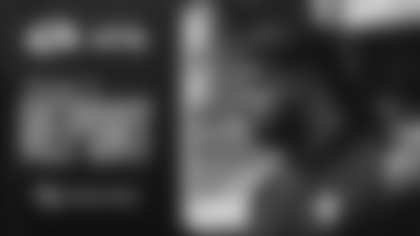LOS ANGELES – NFL officiating and rules analyst Walt Anderson spoke with local media ahead of the Rams' final training camp practice about the league's rule changes ahead of the 2025 season. Among those rule changes are standardization of overtime rules, virtual ball spotting, kickoff adjustments and replay assist changes.
Anderson was an NFL referee from 1996-2019, during which time he officiated two Super Bowls, before transitioning to head of officiating in 2020, and then to his current role ahead of last season. He is the contact for teams during the season if they have questions about officiating or rules, and he works closely with the competition committee, which Rams head coach Sean McVay is a member of.
Here's a closer look at the rule changes ahead of 2025:
Dynamic kickoffs and onside kicks
The dynamic kickoff that debuted last season was made permanent, however they moved the touchback line from the 30 up to the 35-yard line in an effort to increase the number of kicks returned. Last season, the league's analytics experts estimated that this format would result in a return rate between 30-50%. It ended up around 33%, so they are hoping this change will bring that number up, Anderson said.
Another kickoff change will apply to the return team's setup zone off the 35-yard line. Last season, only two players were allowed to line up off that line, this year up to three will be allowed. However, only one such player is allowed in each of the zones between the sidelines and the hash marks and between the hash marks.
For onside kicks, the league moved the 10 players on the kickoff team up from the 35 to the 34-yard line to see if that increases the frequency of recoveries.
"The committee just wants to try that for a year, see if the percentages of recovered onside kicks gets up to a little bit more in the 10-12% range, which is historically where it's been and the league feels more comfortable," Anderson said. "The last several years it has been down around the 5% (mark). It's almost just a no-win play."
Standardized overtime (basically)
The regular season overtime rules will now be essentially the same as the postseason's, but with a different time frame and possibility of a tie.
A first-possession touchdown will no longer end the game. Both teams will now have the opportunity to possess the ball during a 10-minute overtime period (rather than the 15-minute postseason period), unless the first team's drive spans the entire 10 minutes. If the game is still tied after that period, the game will end in a tie, unlike the postseason.
"The committee and ownership felt that it was just fair to give both teams a chance to possess the ball, really regardless of what the first team does, whether they score a field goal or touchdown," Anderson said.
Virtual measurement system
There's a lot of misinformation about what "virtual measurement system" actually means, Anderson explained. Officials will still spot the ball on each play, but this system will replace the chain gang on first-down measurements after the referees spot it. They are not using the ball-tracking technology to spot the ball.
Coaches can challenge the spot of the ball, but the chain gang will not go out to measure it, the virtual system will.
The chains will still be on the sidelines so players and coaches know where the line to gain is, but they will no longer be run onto the field for measurements unless the virtual system fails. There are six cameras in each stadium that are spaced every 20 yards from goal line to goal line, and their purpose is to take a snapshot of the ball after it's placed on the ground by an official.
The league has been "experimenting and testing" the virtual measurement system for the last few years, Anderson said. They used it in the Hall of Fame game between the Chargers and Lions last week, and it took just 17 seconds to process and communicate the accurate spot of the ball – in relation to the first-down marker – to officials on the field.
"It's roughly accurate within a quarter of an inch... which is more accurate than the chain group," Anderson said.
So, while many fans have taken "virtual measurement system" to mean tracking chips determining the spot of the ball, that is not the reality. However, it seems as though that's the eventual goal.
"This system cannot determine the location of the ball before it's placed on the ground," Anderson said."... It's heading in that direction. And if you want to know, it's really just about processing time. Hawkeye, I know, is already working on that. So once they get the powerful enough chips and powerful enough processors... we'll get there."
Replay assist
Over the past few years, replay assist has been added to different aspects of officiating. It can now be used to pick up fouls with "objective criteria," Anderson said, such as roughing the passer. This year, they've added hits to the head on defenseless players (the most common being downfield receivers and sliding quarterbacks) and facemask penalties to that group of reviewable penalties.
To be clear, teams cannot challenge a play to induce a flag if none is called, they can only challenge to pick up such penalties. The competition committee did debate on that, but they decided against it because so many little things happen each play that it would cause too many stoppages and possibilities for review that would slow the game down.
"A lot of time was spent about whether or not the committee or ownership really wanted to entertain (replay assist putting flags on the ground)," Anderson said. "... When you really start looking at how that would impact the game from that standpoint, we would have to re-officiate on video every play."














